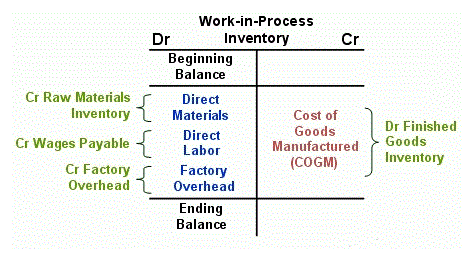
In order to gain this insight, your organization will need to have visibility into end-to-end spending. Calculating the cost of goods manufactured helps businesses determine the total cost incurred in producing goods ready for sale, aiding virtual accountant in pricing decisions and financial reporting. Direct labor refers to employees directly involved in production tasks, while indirect labor includes employees who support production indirectly, such as supervisors and maintenance personnel.
Transformative Data
- Work in progress (WIP) in manufacturing refers to partially finished products at various stages of production, and it’s a key concept in efficiency.
- Total manufacturing cost, when compared with income and revenue, provides clarity around profitability and overall business performance.
- Unfinished products incur additional costs for storage, handling, and tracking costs, increasing the financial burden.
- That’s where it’s valuable to enlist the capability of an ERP system that can help you manage your total manufacturing costs.
- Direct Labor Cost comprises the wages, salaries, and benefits paid to employees directly involved in the manufacturing process.
Build effective supplier relationships to ensure that you get the direct materials you need when you need them. Implementing service level agreements aid transparency, support product delivery schedules and help to maintain consistent materials quality. Then, subtract the variable costs from the total and multiply it by the amount of product trial balance for the given production period. Total manufacturing cost is calculated by adding a business’s material, labor, and overhead expenses. The cost of labor includes employee pay, benefits, labor taxes and contributions, and workers’ compensation insurance. The total manufacturing cost variance is the negative or positive gap between the actual and the standard manufacturing costs.

The relationship between total manufacturing cost and productivity
This financial metric also helps companies identify areas of overspending or underutilization, which aids in controlling costs and optimizing profit margins. Simply put, total manufacturing cost is the overall sum of money required to manufacture a product. It is calculated by adding all the expenses incurred during production, which include the cost of direct materials, money spent on labour, and other overhead manufacturing expenses. The three primary components of total manufacturing cost are direct materials, direct labour, and manufacturing overheads. Total Manufacturing Cost (TMC) refers to the overall money spent on the production activities for processing the raw material into finished goods in a given period (quarter or year). It involves three significant expenses, i.e., direct material cost, direct labor cost, and factory or manufacturing overheads.
Six New Features in HVI to Improve Safety Management
- For example, for a soda producer, water is used as a direct material, forming the body of the drink.
- COGS calculates the costs of items that not only finished the product creation journey but also got sold to a customer.
- They typically become integral components of the product and can be easily traced back to it.
- This information will dictate key decisions around your company’s direction, such as whether to be cautious or bold (and therefore whether to make cuts or to invest in core functions).
To calculate the manufacturing overheads, add all the indirect costs and allocate them to each product unit. The basis for allocation could be any relevant measure that reflects the activity level of production, like total labor hours, total machine hours, or sales. To identify direct labor costs, you need to separate employees total manufacturing cost formula who play a direct role in the production line. These include machine operators, assemblers, quality control staff, and line workers. Team members not handling the production process — like supervisory staff, accountants, cleaning staff, and maintenance workers — are included in indirect labor.
Analyzing the cost of production helps businesses make informed decisions about pricing, resource allocation, and profitability. For instance, a clothing manufacturer can determine whether a specific line of clothing is profitable by comparing its production costs to the revenue generated. Let’s look into two practical examples that highlight the implications of mastering the total manufacturing cost formula in everyday business operations. Moreover, the total cost formula extends beyond mere calculations; it encompasses the entire supply chain. Factors such as logistics, inventory management, and supplier relationships play a pivotal role in determining overall costs. For instance, optimizing transportation routes and reducing lead times can significantly lower costs, enhancing competitiveness in a global market.

These are the hours spent by workers who are directly contributing to the production process. Small details that may only amount to small expenses can still collectively make a big impact on your business. Common methods include Activity-Based Costing (ABC), which allocates costs based on activities performed, and traditional methods like allocating overhead based on direct labor hours. In a furniture manufacturing company, ABC might allocate costs by considering activities like design, cutting, and assembly, providing a more accurate distribution of overhead costs. A furniture manufacturer, for example, might analyze its sales trends to determine the ideal stock of wood and materials that balances production efficiency with cost savings. This approach not only reduces costs but also increases responsiveness to market demands.
Inside Magna’s Strategy: Winning Business Through Early Customer Collaboration
By analyzing these costs in relation to production levels, companies can better forecast expenses and adjust their operations accordingly. This proactive approach helps in maintaining a competitive edge, especially in industries where profit margins are tight and efficiency is paramount. Understanding the total manufacturing cost (TMC) is essential for any business with production-based operations.


The total manufacturing cost formula can be used alongside your net revenue to work out how profitably your business is producing goods. The higher your production costs, the thinner your profit margins are likely to be. Indirect production costs are expenses not directly tied to a specific product, like rent, utilities, and equipment maintenance.
